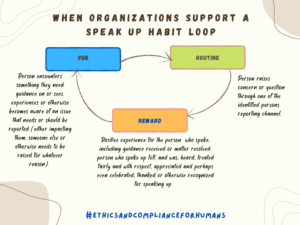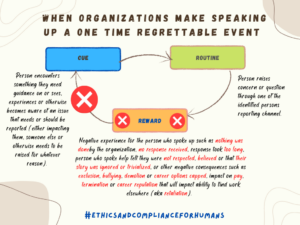Post by Adam D. J. Balfour
A speak up culture is an important element of sustaining an effective ethics and compliance program and an indication of whether or not the program is working in practice. A speak up culture is not simply the individual responsibility of anyone who should, or wants to, speak up – it is a collective responsibility to ensure that speaking up becomes a habit and an individual and organizational norm, and not a one time immediately regrettable event for the person speaking up (or deter others if they see or hear about the bad experience others have gone through when speaking up). As many Codes of Conduct encourage, people who have relevant information should speak up – but that alone won’t build a habit or culture of speaking up. The organization has to listen to the person (including their story and not just facts relevant to potential liability for the organization) and ensure that the person is, and feels, listened to and that the process provided a more positive outcome than not speaking up. Cue; routine; reward; repeat (aka the habit loop).
While perhaps overly simple (and missing some other things that organizations can do to build a speak up culture), the below images show the differences in how to create a speak up culture through the habit loop and how to not have a speak up culture by breaking the loop. The images might be overly simple, but in some ways I think the concept of creating a speak up culture is fairly simple – listen to people, treat them with respect, appreciate and recognize them for speaking up and continuously build trust.
People who speak up are people who care, and organizations should in turn take care of these people. People should be rewarded for speaking up – otherwise an organization cannot expect to build or maintain a speak up culture.


